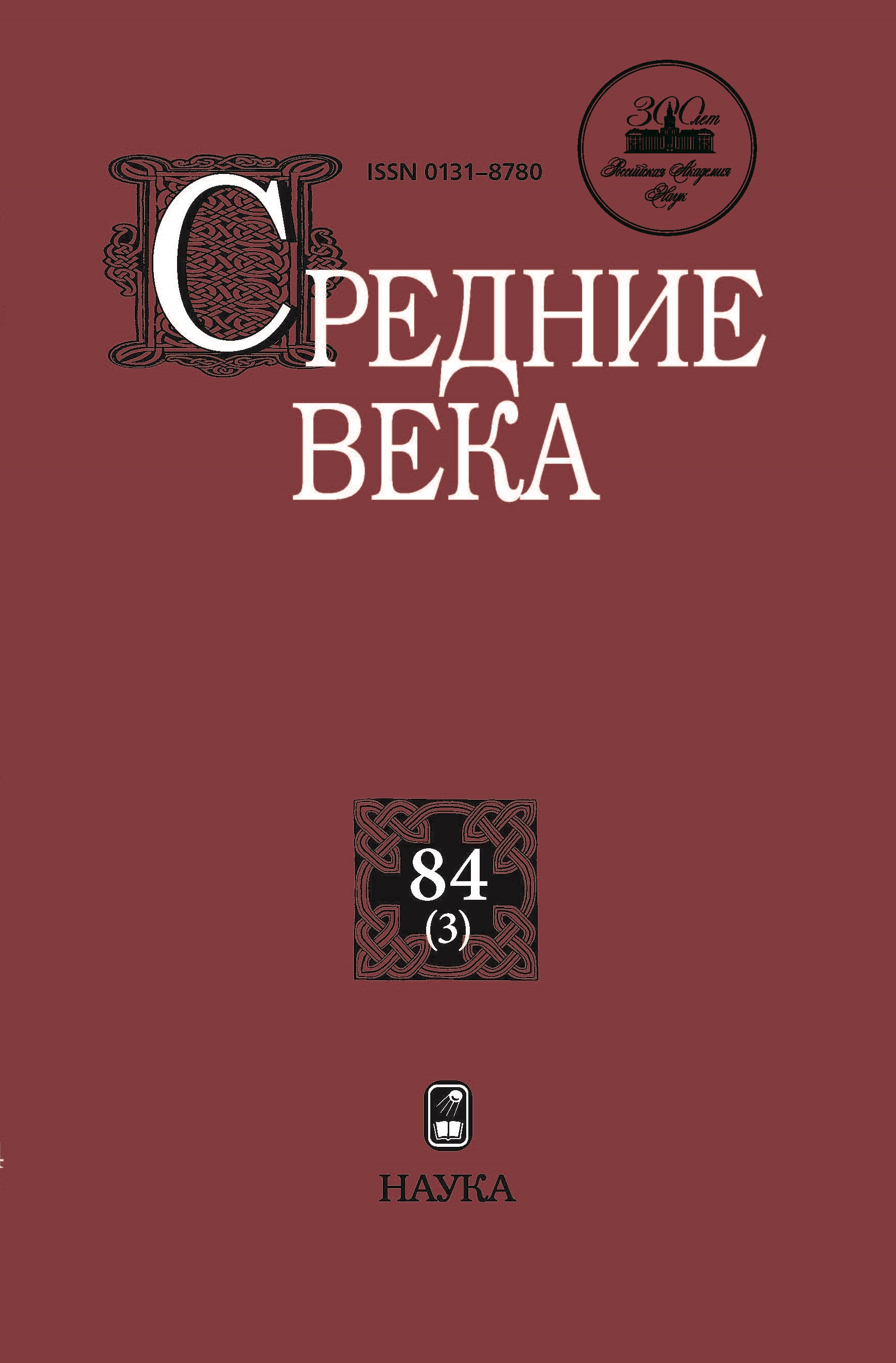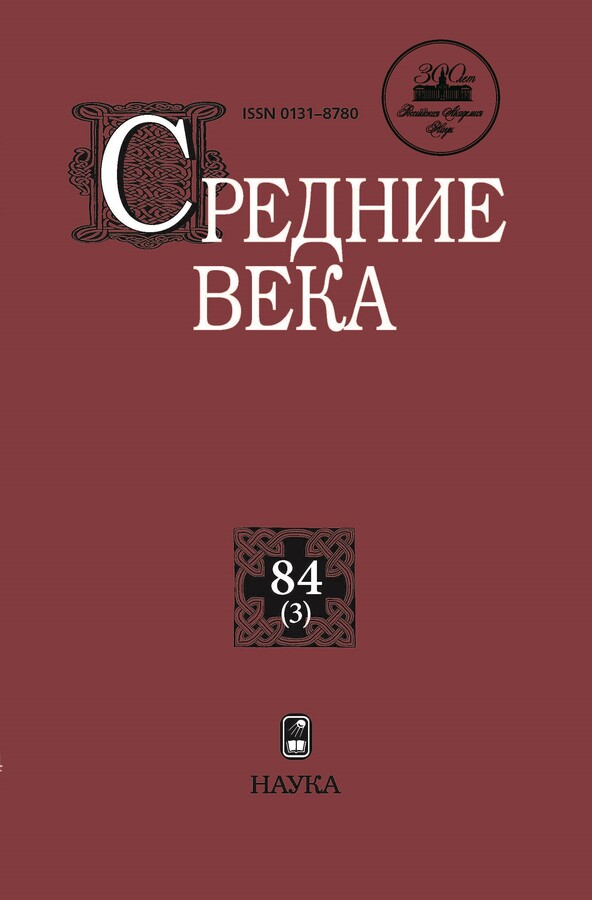Srednie veka
Historical quarterly journal.
Editor-in-Chief
- Pavel Yu. Uvarov, Corresponding Member of the Russian Academy of Sciences, Head of the Department of Western European Middle Ages and Early Modern Times of the IVI
Publisher
- Publishing House "Science"
Indexing
- RSCI
- Scopus
- Google Scholar
- CrossRef
Frequency of release
- 4 issues per year
About journal
The academic periodical edition on history of the Middle Ages and early Modern Times in Latin Europe is a publishing body of Russian professional community of medievalists. Founded in 1942 under the authority of Academy of Sciences of the USSR, it has been published annually to present day. It became a quarterly edition since 2007.
Current Issue
Vol 84, No 3 (2023)
Articles
Editor’s Note
Srednie veka. 2023;84(3):5-7
 5-7
5-7


Congratulatio
Srednie veka. 2023;84(3):8-8
 8-8
8-8


Jean-Puerre Poly: Historian Among Lawyers, Lawyer Among Historian
Abstract
This article provides basic facts about the career and research of J.-P. Poly, a specialist in legal and social history of the Middle Ages and one of the most influential and interesting French medievalists of our days. It also contains a short characteristic of his article published in this issue of the journal.
Srednie veka. 2023;84(3):9-14
 9-14
9-14


Imago Imperii: The Barberini Ivory and the Romanic World of Provence in the 6th – 8th Centuries
Abstract
The article is dedicated to one of the most remarkable and mysterious artefacts of the Early Middle Ages known as the Barberini ivory and to the inscriptions written on its reverse. Proceeding from the generally accepted idea that this artefact was produced in the imperial workshops of the Eastern Roman empire as well as from the political context of the 6th century, the author traces the history of the ivory in that period and comes to the conclusion that it was probably designated as a gift for one of Justinian’s military commanders who played a major role in the conquest of Italy from the Ostrogoths. The author identifies him as Constantianus, a descendent of emperor Constantius III (421). According to his hypothesis, in 566, after the unquiet death of Justinus, son of Justinian’s first cousin Germanus, a comrade-in-arms of Constantianus, the latter’s family fled from the Empire to Provence controlled by the Franks taking along the precious ivory. Subsequently it found its way into the treasury of the archbishops of Arles where it evidently remained until the beginning of the 17th century. Basing on the inscriptions on the artefact’s reverse and a number of other sources the author analyses the vicissitudes of the political strife in Francia in mid-6th – early 7th centuries of which the aristocracy and the high clergy of Provence were a part and offers a plausible explanation of Constantianus’ family decision to part with the ivory. The study of anthroponymic data from these sources led him eventually to study the problem of ethnic and cultural identity of Provencal elite of this and somewhat later period. The author comes to the conclusion that at least until mid-8th, probably even until mid-9th century, this elite retained its Romanic identity.
Srednie veka. 2023;84(3):15-47
 15-47
15-47


To Create a Dynasty. «The Kin of Sverre» And Norwegian Medieval Inheritance Law
Abstract
The article suggests a hypothesis that in so-called periods of «civil wars» (1130–1240) and «epoch of greatness» or «storhetstiden» (1240–1319) in Norway there was prospective and retrospective dynastic planning as part of the state policy. It provided by order of Sverrir, an impostor, who become the king of Norway, and his successors («the Sverrir clan») this planning and realized by the compilers of sagas and laws who were in their service. The main methods of this planning were manipulation of historical memory reflected in the monuments of historical writing, and also name-giving. By the use of these methods within the dynasty of the Norwegian kings from its legendary founder Harald Fairhair and the «Sverrir clan» as its part were modeled linages as specific mental schemes. They did not reflect real agnatic structures as representations of kinship relations, which had to connect real and imaginary ancestors and descendants. These constructions were intended for legitimizing of the origin and rights to power both Sverrir himself and those representatives of the royal dynasty he descended from as well as his own offspring. Lineages were composed both of those members of the royal family who had the same names, which made the descendants like their ancestors, and on the basis of similar kinship configurations that appeared as a result of marriages between representatives of the royal dynasty and the Norwegian nobility. The need of dynastic planning was closely linked to changes in Norwegian inheritance and family law. The article shows how the situation within the «Sverrir clan» influenced to the formation of succession laws of 1273 and 1302, and the assertion of the principle «Norway is the king’s honor» led to the contamination of their norms with the general inheritance law ones.
Srednie veka. 2023;84(3):48-84
 48-84
48-84


Participation of Sofia Рaleologus in Court Ceremonies
Abstract
The article examines evidence from sources of various origins about Sofia’s participation in court life in Moscow. It is noted that such evidence is not too numerous, and only three of them are associated with the reception of foreign ambassadors. The collected material allows us to conclude that the role of Sofia in court ceremonies was significant, but was, first of all, symbolic: Sofia personified the connection from the court of Ivan III with the West, as well as the family happiness of the sovereign as the mother of his children and as the «head» of the female part of his family. It is indicative in this regard that the news about Sophia’s participation in ceremonies related to the marriage of her daughters is especially vivid. All these roles were due to the tasks set by Ivan III and his approximate tasks in foreign and domestic policy, but they were hardly associated with direct or indirect personal initiatives of the «ospodarynia» in governing the country. Her ceremonial role was subordinate to the main role, which belonged to the Grand Duke.
Srednie veka. 2023;84(3):85-107
 85-107
85-107


Written Sources for Dudo of Saint-Quentin’s «Historia Normannorum» (Posing the Problem)
Abstract
This article is an attempt to identify the written sources of the chronicle of the French monk Dudo of Saint-Quentin created in the early 11th century and entitled «De moribus et actis primorum Normaniae ducum», known also as «Historia Normannorum». It is the first text dedicated to the history of Normandy and a text based mainly on the oral information obtained by Dudo from the dukes of Normandy and their entourage. This fact attracted many modern scholars whereas Dudo’s written sources received much less attention which hinders attempts to explain certain factual lacunae in his text and occasional mismatches of his reports with the reports of other authors of the same period, something which for a long time discredited this chronicle in the eyes of researchers. Striving to identify the written sources which Dudo employed while composing his chronicle, the author clarifies the chronicler’s literary aims and the particularities of his work with available sources. This, in turn, helps to properly assess the originality of his work and the reliability of the reports contained in his chronicle.
Srednie veka. 2023;84(3):108-128
 108-128
108-128


The Ottoman Conquest of Constantinople Mentioned by English Chroniclers the Second Half of the XV – Early XVI Century
Abstract
This article examines the reports submitted by the English chroniclers of the second half of the XV – early XVI century. The reports are dedicated to the capture of Constantinople in 1453 and the subsequent Turkish conquests. The analysis of a number of chronicles revealed the sources that guided their compilers, and it also concluded that the English chroniclers, in general, were aware of the main circumstances of the city’s fall and the increasing Turkish danger to southern Europe. Also of interest is the publishing activity of William Caxton (c. 1422–1491). He sympathized about the crusading movement and tried to encourage compatriots to support the idea of an anti-Turkish campaign. Information about the advance of the Turks in the Balkans is contained in the 1419–1461 continuation of the chronicle «Brut» and the eighth book (Liber ultimus) of the Universal Chronicle of Ranulf Higden (in English translation by J. Trevisa) – both were composed by Caxton.
Srednie veka. 2023;84(3):129-146
 129-146
129-146


«By Lowdoun Hill Mete Hym Sall I». John Barbour’s Poem: Books VII–VIII
Abstract
John Barbour (ca.1320–1395) has been justly acknowledged as the founder of literature in Scots. The Bruce, his monumental achievement, is at once a metrical romance, a biography of Robert I, King of Scots, and his loyal adherents,and a historical chronicle which became the national epic of Scotland. The first full Russian translation of this outstanding work is continued below, with an introductory article and commentary. The original metre is retained.
Srednie veka. 2023;84(3):147-160
 147-160
147-160


 161-176
161-176


Jean Bodin’s «Six Books of the Commonwealth» in English Political Works of The 17th Century
Abstract
The paper is devoted to the perception of the political ideas of the French philosopher Jean Bodin in the English intellectual space of the 17th century. English political thought during the 17th century more than once changed its direction responding to political crises in the country. The authors of the pre-revolutionary period, the Civil War and the Stuart Restoration evaluated the theory of sovereignty in different ways and saw different ways to implement it. In this context the quoting of Jean Bodin, already then recognized as an author of the theory of state sovereignty, often appeared in the writings of English authors. The number of references to Bodin makes it difficult to study the reception of Bodin’s political ideas in seventeenth-century England through a frontal review of these writings. The author of the paper has compiled a selection of English works from the period 1576 to 1700, which cited Bodin’s treatise «Six books of the Commonwealth». The resulted base consists of 298 works of numerous authors. Throughout the 17th century the public interest in Bodin varied depending on the political situation. The peaks of his citations coincided with political crises in England; they became the foundation for research work with the collected corpus of sources. The study This attempts to trace how, in the process of reading, different evaluation and interpretation of Bodin’s treatise, English readers influenced the subsequent perception of the text and its author.
Srednie veka. 2023;84(3):177-197
 177-197
177-197


Sir John Fern and Formation of Antiquarian Narrative on Nobilitas
Abstract
This paper examines Sir John Fern’s treatise «The Blazon of Gentrie deuided into two parts» in the context of the formation of the tradition of reasoning about nobilitas and about the «social» in general, the consolidation of which is usually associated with antiquarian historical writing. It is assumed that the range of subjects and issues related to nobility proposed by Fern served as a kind of matrix for subsequent treatises on the nobility, created with the involvement of technologies of antiquarian discourse. In Fern’s view, the nobilitas structure had a relatively homogeneous character, translating its internal unity, and went back to metaphysical and ethical origins, which defined it mainly as a static system. In the antiquarian discourse, with the formally preserved unity of the nobility, indicated in Fern’s text, the emphasis shifts towards the «hierarchy of titles», and the boundaries of the nobility acquire a more pronounced functional character. In the texts of the early Stuart theorists, the structure of nobilitas is complemented by a dynamic dimension, which is reflected in their consistent historicization of phenomena (titles and virtues) and thus contributes to the «birth of the social».
Srednie veka. 2023;84(3):198-215
 198-215
198-215


In Memory of Leonid Borisovich Alaev
Srednie veka. 2023;84(3):216-216
 216-216
216-216












